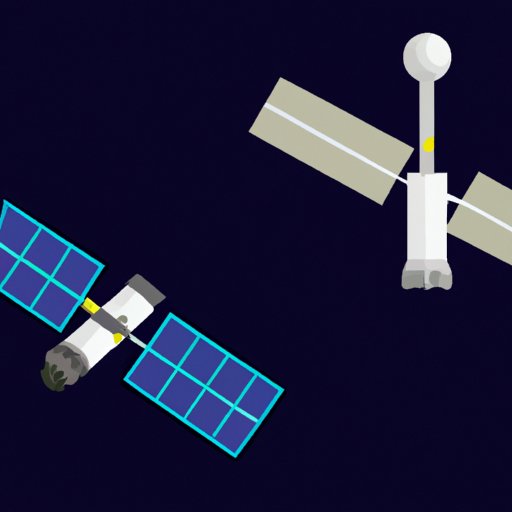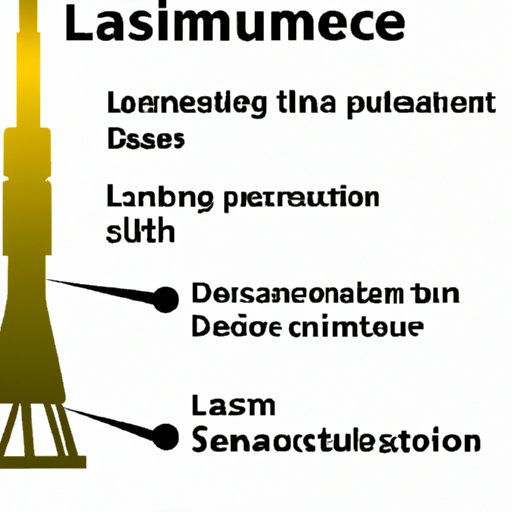Introduction
Satellites have become an essential part of our daily lives, providing us with access to global communications, GPS navigation, weather forecasting, and more. But how much does it cost to build and launch a satellite? In this article, we’ll explore the factors that influence the cost of a satellite, including the size and power requirements, launch vehicle and location, and additional services needed. We’ll also discuss the differences between commercial and government satellites, as well as the costs associated with maintaining a satellite in orbit. Finally, we’ll look at potential savings that can be made by reusing existing satellites.

The Cost of Launching a Satellite
The cost of launching a satellite depends on a number of factors, including the size and weight of the satellite, its power requirements, the type of launch vehicle used, the location of the launch site, and any additional services required for the launch. For example, a small CubeSat weighing less than 1 kg might cost around $50,000 to launch, while a larger satellite weighing several hundred kilograms could cost several million dollars.

Factors That Influence the Price of a Satellite
Let’s take a closer look at the factors that influence the cost of launching a satellite.
Size and Weight of the Satellite
The size and weight of the satellite are key factors in determining the cost of launch. A larger, heavier satellite requires a more powerful launch vehicle and consumes more fuel, leading to higher launch costs. Additionally, larger satellites often require additional services such as tracking, telemetry, and command (TT&C), which add to the overall cost.
Power Requirements for the Satellite
The power requirements of the satellite also influence the cost of launch. A satellite with higher power requirements will need a more powerful launch vehicle and additional services, resulting in higher launch costs. Additionally, higher power requirements may necessitate the use of multiple launch vehicles or additional boosters, further increasing the cost.
Launch Vehicle and Launch Location
The type of launch vehicle and the location of the launch site can also affect the cost of launching a satellite. Different launch vehicles have different capabilities and associated costs, ranging from small rockets for launching CubeSats to large rockets for launching heavier satellites. Additionally, the location of the launch site can also affect the cost, as some locations may require additional permits or services.
Additional Services Required for Launch
Finally, there are additional services that may be required for the launch, such as tracking, telemetry, and command (TT&C) services. These services can add significantly to the cost of the launch, depending on the complexity of the mission.

Differences Between Commercial and Government Satellites
The cost of launching a satellite can vary significantly depending on whether it is a commercial or government satellite. There are several key differences between the two types of satellites:
Cost of Development and Production
The cost of developing and producing a commercial satellite is typically much higher than that of a government satellite. This is due to the fact that commercial satellites are often designed to meet specific customer needs, whereas government satellites are usually designed to meet general requirements.
Availability of Launch Vehicles
The availability of launch vehicles is another major difference between commercial and government satellites. Government satellites typically have access to larger, more powerful launch vehicles, such as the Space Shuttle and Delta IV Heavy, while commercial satellites are often limited to smaller, less powerful launch vehicles.
Regulatory Requirements
Finally, there are significant differences in the regulatory requirements for commercial and government satellites. Government satellites must adhere to strict regulations set by international organizations, while commercial satellites typically have fewer restrictions.
Costs Associated With Maintaining a Satellite
In addition to the initial cost of launching a satellite, there are also ongoing costs associated with maintaining a satellite in orbit. These include fuel costs, ground station costs, and maintenance fees. Fuel costs include the cost of the fuel itself, as well as the cost of storing and transporting the fuel. Ground station costs include the cost of maintaining the infrastructure necessary for communicating with the satellite, such as antennas and computers. Maintenance fees cover the cost of repairs and upgrades to the satellite.
Potential Savings From Reusing Existing Satellites
There are potential savings that can be made by reusing existing satellites, rather than building new ones. Reusing components from existing satellites can help reduce the cost of building a new satellite. Additionally, reusing existing launch vehicles can help reduce launch costs. Finally, utilizing existing networks of satellites can help reduce the cost of maintaining a satellite in orbit.
Conclusion
The cost of launching a satellite can vary significantly depending on the size and weight of the satellite, its power requirements, the type of launch vehicle used, the location of the launch site, and any additional services required for the launch. Additionally, the cost of launching a satellite can vary significantly depending on whether it is a commercial or government satellite. Finally, there are ongoing costs associated with maintaining a satellite in orbit, such as fuel costs, ground station costs, and maintenance fees. Potential savings can be made by reusing existing satellites, launch vehicles, and networks.
Summary of Key Points
In summary, the cost of launching a satellite depends on a number of factors, including the size and weight of the satellite, its power requirements, the type of launch vehicle used, the location of the launch site, and any additional services required for the launch. Additionally, the cost of launching a satellite can vary significantly depending on whether it is a commercial or government satellite. There are also ongoing costs associated with maintaining a satellite in orbit, such as fuel costs, ground station costs, and maintenance fees. Potential savings can be made by reusing existing satellites, launch vehicles, and networks.
Recommendations for Reducing the Cost of Satellite Launches
To reduce the cost of launching a satellite, it is important to consider the size and weight of the satellite, its power requirements, the type of launch vehicle used, the location of the launch site, and any additional services required for the launch. Additionally, using existing satellites, launch vehicles, and networks can help reduce costs. Finally, it is important to compare the costs of commercial and government satellites in order to determine the most cost-effective option.
(Note: Is this article not meeting your expectations? Do you have knowledge or insights to share? Unlock new opportunities and expand your reach by joining our authors team. Click Registration to join us and share your expertise with our readers.)
